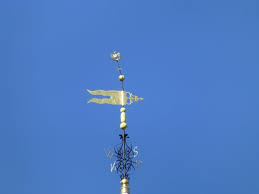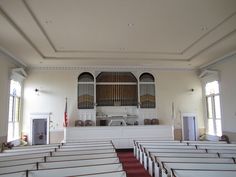
When I was a little kid, my family moved to a small, New England town. As we drove, the elephants I smelled on the wind turned out be cows in a soggy pasture. We had just moved from a big city to the land of the Macintosh apple and the Guernsey cow.
...sometimes there would be fresh snow, sparkling white on the granite steps.
Clearly, our new world was new, so my parents brought us to church to nurture our embryonic social life. True, it was paradoxical that my parents were socialists and had been part of the Communist Party in the 1930s, but they knew the value of community, so off we went to church.
The town was old, incorporated in 1756. The church, nearly as old as the town, stood tall thru its two centuries. It boasted peg-and beam construction, broad-sawed timbers and hand-hewn stairways, all still exposed inside the cob-webbed attic. A pitched slate and copper roof bifurcated along a ridge rafter while eaves sheltered white clapboard siding and stained-glassed windows. The whole vessel held court, dignified and perpetual, on a sea of mammoth granite blocks, quarried nearby.
 True to New England tradition, our church boasted a tall but unadorned steeple that rose skyward to a gold-painted wind vane, a stiff pennant that squeaked whenever the wind changed direction. My old man thought the squeaking pennant looked like a gold-plated pair of long johns hung out to dry. He was right. It did.
True to New England tradition, our church boasted a tall but unadorned steeple that rose skyward to a gold-painted wind vane, a stiff pennant that squeaked whenever the wind changed direction. My old man thought the squeaking pennant looked like a gold-plated pair of long johns hung out to dry. He was right. It did.
My old man taught astronomy and physics in Sunday school. Nobody in the church stopped him because he spoke truth when he intimated that science might hold more wonder and meaning than religion. Besides, we had joined a Unitarian congregation, a gathering place guided only by a free and responsible search for truth and meaning.
The truth and meaning thing pretty much clinched it for us because science and this church — we didn’t call it religion — were both doing the right thing. Besides, my mom liked to sing in the church choir — she had a very pretty voice — where she carried on a formal and nearly unnoticeable flirtation — she was very pretty — with the local doctor. It all worked out okay.
The church minister liked my old man, even though he taught science in Sunday school and nodded off during every Sunday sermon. The poor guy was in better shape at the end of a work week when we stayed home and he made crepes and orange sauce and powdered sugar and we all joked around together.
Talk about tradition. Here we were, attending a picture-postcard ceremony in a venerable New England church. I sang in the choir, songs whose verses I could never remember. Later I realized why. The words were meaningless. Stuff about shepherds and multitudes upon high, and grateful flocks. Who can remember that crap? They all sounded like jesus was supposed to look, with his golden locks and wispy beard.
The picture-postcard syndrome thickened at Christmas. We did a candlelight service on Christmas eve, and sometimes there would be fresh snow, sparkling white on the granite steps. We took off our snow clothes and donned white surplices and sat on a dais below the stained-glass windows. On the columns between the stained-glass windows, candles flickered warmth above fresh boughs of fir.
 Inside, this was no gaudy trump of a church. We’re talking New England austere but elegant — all white woodwork, the stage below the pulpit white, the pews white with their dully polished cherry wood railings.
Inside, this was no gaudy trump of a church. We’re talking New England austere but elegant — all white woodwork, the stage below the pulpit white, the pews white with their dully polished cherry wood railings.
The minister, that’s how they address the god guys in Unitarian, gently inherited the pulpit from an old Brahmin, a member of Boston’s ruling-class families whose responsibility it was to guide and perpetuate the worldviews and the values of their forefathers. And yes, I use “forefathers” advisedly. There were no books written about women participating in the American Revolution. None.
The new minister reflected a new take on his predecessor’s responsibilities. The Cold War might have blown outside the frosted stained glass panes, and Reverend Tilson had no Brahmin pedigree but, as he settled nicely into his new congregation, he slyly revealed an earthy sense of American humor, maybe a little like Garrison Keillor’s.
The wheezy pipe organ had just been restored to its former magnificence and the choir always found pretty music to sing, Bach and some of the other old guys. This before folk music found its way into liberal churches. My mother was up there singing hymns, she looked so serious and passionate when she sang. Not pious, not religious, just intent.
The glow inside the lofty church nave became magic over Christmas. I was young enough to still be able to say “Wow! I can’t believe my eyes. It’s finally Christmas eve…” It was one of those moments that you thought, “I’ll never forget this as long as I live.”
Plenty of those moments disappear with time, but others remain. This scene was a keeper, with the candlelight filling the old structure, the bellowing organ, all the little candles perched on the dark green boughs and cone clusters waving in the draughts from the leaky old windows. A tinder box tragedy in the making but these Unitarian folk were wood folk, they knew their pines and firs and cows and apples.
The Unitarian faith, ensconced in the heart of American’s transcendentalism, expressed the pre-bohemian faith of the Emersons, Thoreaus, Whitmans spoke from generations of Cabots and Lodges and Lowells and Adams and the Coffin family’s whale-oiled wealth. Tradition lay everywhere in that church, from its mighty hewn beams to its yearly candlelight service. Despite my later rush toward anarchy, I loved that church and its people.
*
It’s difficult to know, in the midst of today’s unprecedented upheaval, how to relate to such a deep, stable history. Every thing is up for grabs now, again, for the third time in my life. That church stands strong, I am sure, but right now, all that it stood for feels frozen, like a roadside nativity scene that skates by in your peripheral vision and disappears in the rear-view mirror.
# # #
Writer, editor, and educator based in Los Angeles. He's also played a lot of music. Degelman teaches writing at California State University, Los Angeles.
Degelman lives in the hills of Hollywood with his companion on the road of life, four cats, assorted dogs, and a coterie of communard brothers and sisters.



Living as I do, in New England, your scene feels quite familiar, though I don’t actually attend church. You describe yours with perfect exactitude and loving memory. We have a church just like it around my corner on Martha’s Vineyard. They have civic programs there too, so I have been inside many times. It is a Congregational Church. By the way, my house in Edgartown is the Holmes Coffin House, built by his brother Jared in 1829. Jared’s 1823 house is across the street. Holmes was the brick mason who laid the stone foundation. He died in 1831 while on a business trip to Nantucket, but the house stayed in the family for two more generations. I’ve done research on the house. We all need touchstones to the past.
Thanks for the good words and the historical. I’ve probably walked past your Edgartown house on jaunts with my pal Paul, also a Harvard alum. I have a friend who recently died, but who owned an amazing house on the bay in Duxbury, or, as he liked to call it, deLuxbury ;-).
Write on!
Reading this piece is like reading a prose poem as is much of your writing. The rhythms rush and slow our minds along the way, sometimes making a need to reread, to make sure one hasn’t missed a gem. I know you will keep writing.
Thanks, Rosie. Can’t stop writing.
So many wonderful details in your description, you really bring that church to life. I’m amazed that you remember it all so clearly. I love the weathervane that looked like a pair of long johns (with a perfect picture to illustrate it), your father teaching science in Sunday school, your mother singing intently in the choir, and you forgetting the words to songs about shepherds and flocks.
I was moved by your last paragraph, about looking back in the midst of today’s upheaval. It’s so hard to know what to think any more.
Thanks for this, Suzy. I was amazed that I forged such a tranquil scenario in the midst of civil war.
Thank you, in the midst of our 21st-century angst and nastiness, for giving us this portrait of a simpler America where people just wanted to get together, sing hymns, and form a community.
I was refreshed by the tranquility I found (briefly 😉 in writing this.
Love timber framed buildings.
Then you’d love this old building, Constance. BTW: graphic is the real thing, a photo of the Unitarian church I describe4 in this post.
How great that your photo is the actual church you went to. Was it a picture you took, or did you find it online?
No, I didn’t take the photo, I think I found it in the town’s historical society web pages, including the inside photo of the organ, the choir box, the pews. It all seemed so much BIGGER back then!
Love your writing…all the details and the big picture. I echo Rosie’s thoughts.
Thanks for your support, Barbara. Much appreciated!